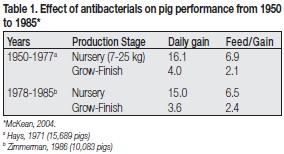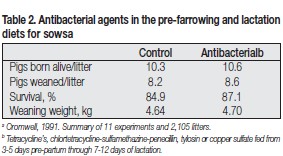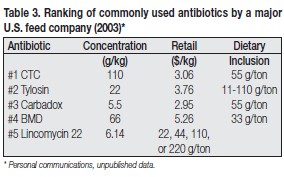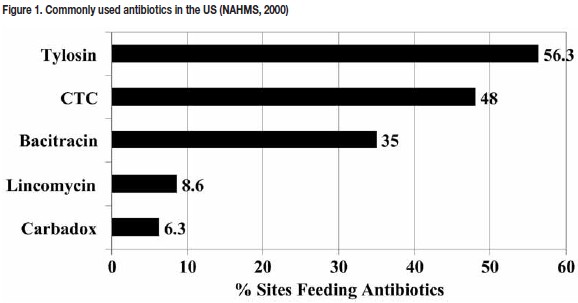Traditional And Non-Traditional Feed Additives For Swine
Feed additives are compounds added to swine diets for the purpose of enhancing animal performance, either directly or indirectly. These compounds MAY elicit a response, and that response is independent of the pig’s energy, amino acid, and vitamin/mineral requirements. However, the response is dependent on age of pig, disease level, genetics, environmental factors, and type of diet/feedstuffs. The purpose of this paper is to provide an overview of the feed additives currently used in swine production, and to provide background information in order to optimize their use.

Antibacterial Agents
Antibacterial compounds (antibiotics and
chemotherapeutics) have been added to swine
feed for over 50 years to treat disease, improve
health, or increase growth performance, and
depending on the additive, are still relatively
effective (Table 1).
Antibacterials can be included at two levels: therapeutic for disease treatment (high dose-short duration) or sub-therapeutic for growth promotion (low dose-long duration). Currently, due to the concern surrounding the development of antibioticresistant bacteria, there is much debate about the continued use of subtherapeutic antibiotics in livestock feeds. In fact, the European Union has banned the use of growth promotants in the feed of food animals, and similar efforts are being made in the U.S. and elsewhere throughout the world. Therefore, pork producers need to be looking for replacements for growth-promoting antibacterials.
As can be seen in Table 1, growth-promoting antibacterials are most effective early in the pig’s life. This is due to the fact that the passive immunity from the sow’s colostrum is declining, and the pig’s own innate immune system has not yet developed. Therefore, antibacterials are very effective in bridging that “immune system” gap in the young pig’s life. In the U.S., over 85% of the nursery pigs receive an antibacterial in their ration (NAHMS, 2000). However, as it gets older and its own immune system develops, the pig responds less to antibacterials for growth promotion. In fact, most U.S. pork producers use little or no antibacterials for growth promotion past 25 kg body weight. Due to improvements in nutritional programs, early weaning, and the pig’s environment, coupled with Allin/ All-out and multi-site production, the disease load has been drastically reduced in most herds. Therefore, the effectiveness of antibacterials is usually reduced below the point where they pay for themselves.

An exception to this is if a herd has a history of a particular disease and they are trying to prevent an outbreak. An example of this would be ileitis. Many farms with high-lean, fast-growing pigs often experience an outbreak of ileitis within three weeks of pigs being moved into the grow-finish barns. To prevent this, antibacterials like Tylan are added at therapeutic levels the first two weeks in the barn, and then they are gradually “stepped down” to low levels or total removal by the time the pigs reach the finishing phase. The subtherapeutic levels used in the finishing phase are for “insurance” against ileitis, not for growth promotion.
Unless there is a problem with conception rates (<85%) and reproductive efficiency, antibacterials are not traditionally used in sow diets in the U.S. If there is a problem, absorbable antibiotics need to be fed at the therapeutic level one week prior to farrowing and then through farrowing. Table 2 shows the benefit of antibacterials in sow diets.

In Table 3, the rankings by use of antibiotics by a major U.S. feed company is shown, as well as their inclusion level and approximate cost. Antibiotics commonly used in the U.S. are shown in Figure 1 (NAHMS, 2000).

The following is a summary of the intended uses of these antibacterials:
Lincomycin:
- reducing severity of mycoplasmal pneumonia
- controlling ileitis
- treating and controlling swine dysentery
- increasing rate of gain in growing-finishing pigs
Tylosin:
- classic antibiotic used for growth promotion
- no withdrawal
- prevent & control ileitis at 100 g/ton
- active against gram (+) bacteria & mycoplasma
- can increase loin eye area in the finishing phase
Carbadox:
- typically in pre-weaning, nursery, & early grower diets
- treatment of clinical outbreaks of swine dysentery
- prevention and control of swine dysentery
- increased rate of mass gain & improved feed efficiency
- 5-wk withdrawal prior to slaughter
- usually too expensive to be used just for growth promotion
Chlortetracycline & Bacitracin:
- typically used as “insurance policies”
- may enhance gain and feed efficiency
- relatively inexpensive
Chemotherapeutic Agents
Chemotherapeutics are chemically synthesized or naturally occurring compounds that inhibit the
growth of microorganisms, with the two most common being copper sulfate and zinc oxide. While
both copper (6-11 ppm) and zinc (75-125 ppm) are essential minerals for normal growth performance,
they can act as growth promotants at higher levels. Copper possess antibacterial and antifungal
properties and is an effective growth promotant at 100-250 ppm, especially in nursery diets. Also,
copper exhibits an additive effect when used in conjunction with antibiotics. Zinc oxide at 1500 to
3000 ppm fed for 2-3 weeks post-weaning is effective in controlling post-weaning diarrhea.
A concern with the extended use of high concentrations of copper sulfate and zinc oxide is that high levels of these minerals are also excreted in the manure, and can potentially cause environmental problems. In several European countries, public concern has mandated restricted use of these products to prevent the build up of copper and zinc in the soils. It should also be noted that continued use of high levels of zinc oxide and copper sulfate may have toxic effects on pigs. Therefore, care must be exercised when using these products, and it is imperative to know the base level of supplemental copper and zinc in the diets to be able to calculate the total amount (normal + growth promoting levels) of these minerals in the diet.
Organic Acids
Organic acids are commonly added to swine diets as acidifiers and mold inhibitors. Potential modes
of action for acidifiers include: decrease in stomach pH resulting in greater protein digestion and
slower stomach emptying; improved environment for “good” bacteria; reduction in E. coli, Salmonella,
and other gut-associated pathogens. Commonly used organic acids are fumaric, formic, citric, &
proprionic acids, along with mixtures of these acids. The main phase where an organic acid response
can be observed is in the nursery phase, and then it decreases, as the pig gets older.
Probiotics/Prebiotics
Probiotics are a class of feed additives consisting of living bacteria and/or yeast cultures fed to improve
desirable microflora balance within the small and large intestine (McKean, 2004). Most common
mixtures contain one or more of the Lactobacillus species, Bacillus subtilis, Streptococcus faecium,
Saccharomyces cerevisiae and other commenseal species. To be effective, the desirable microbes
must establish as normal inhabitants of the intestinal tract of healthy animals by surviving and flourishing
in the gut environments. These mixtures are thought to work by either directly excluding harmful
bacteria or by reducing intestinal pH to indirectly favor the development of other desirable healthpromoting
microorganisms which compete with harmful bacteria to reduce their presence in the gut.
The desired effect is to improve weight gain and feed efficiency by improving gut digestion and
reducing pathogenic organism loads.
Although probiotics have been commercialized and available for more than 50 years, documented evidence of their therapeutic and nutritional value has been quite variable. Possible reasons for the lack of consistent results are low or variable viability of microbial cultures, strain differences in cultures selected, dose level and frequency of product feeding, antimicrobial and feed ingredient interactions which reduce/neutralize viable colonies before feeding, and composition of diet. Further research may refine the products and conditions of use, which will ensure reproducible results.
Prebiotics may be defined as food/feed substances that beneficially affect the host by selectively stimulating growth or activity of favorable bacterial species in the gut (McKean, 2004). They represent an emerging area of research interest with potential for inclusion in feed rations of swine. Current prebiotics are primarily derived from oligopolysaccharide compounds. These compounds provide nutrient substrates for beneficial bacteria and may be used to selectively boost the colonization of acid-producing bacteria. Many of the advantaged bacteria are similar to those found in probiotic mixtures. Therefore combination regimens of selected prebiotics and probiotic compounds may arise to improve gut health and pig performance. Further research may refine these products, interactions with other compounds, and identify use conditions, which will result in reproducible beneficial results when added to feeds.
Enzymes
Enzymes are added to swine diets to increase nutrient utilization by the pig. Since the majority of swine
diets in the U.S. are composed of corn and soybean meal, enzymes are of little benefit and are seldom
used. However, when alternate feed ingredients like wheat and barley are used, some enzymes have
shown beneficial results. Beta glucanase and xylase are the most commonly used ones, as well as
alpha amylase, cellulase, protease, and various combinations. Enzyme efficacy is dependent of feedstuff
used, processing method, inclusion rate, and composition of the enzyme used. Not all enzymes are
effective, and care must be taken to choose the correct one for each operation.
Phytase is an enzyme commonly used throughout the world, mainly due to environmental considerations. Most of the phosphorus in corn and other grains is in the phytate form, which is largely unavailable to the pig. Therefore, producers supplement diets with inorganic phosphorus (P) to meet the pig’s need, and the undigested P from grain ends up in the manure. Little P from the manure is taken up by plants for growth, so the excess P runs off into rivers and lakes causing “algae blooms”, which seriously affects water quality and aquatic life. However, phytase is very successful in making the phytate P available to the pig, thereby reducing P excretion and the need for P supplementation. Since inorganic P is relatively expensive, phytase additions can lower diet cost and P excretion, which profits producers both economically and environmentally.
Botanicals
Botanicals are compounds derived from roots, leaves, bark, flowers or other parts of plants (McKean,
2004). A number of herbaceous compounds have been proposed to possess useful antimicrobial,
anti-parasitic or antioxidant properties. Botanicals have been reported to increase feed intake, stimulate
secretion of digestive juices and the immune system, provide direct antibacterial activity and improve
oxidative stability in animal products. Recent interest has focused on the potentials for botanicals to
express antimicrobial or antioxidant properties, and to act as alternatives to antimicrobials in feeds.
Oils of various spices may contain natural antioxidants, generally tocopherols or phenoles. Problems
associated with potency evaluation of unrefined products, standardization of active ingredient extraction,
and determination of appropriate inclusion levels for specific effects are current limitations to widespread
use. Additional research to screen various botanicals, to identify and quantify active ingredients for
useful characteristics, and to develop inclusion regimens for antibacterial, anti-parasitic or antioxidant
effects for products currently available is required before science-based recommendations can be
made. However, initial research trials indicate that some botanicals are effective in improving feed
efficiency in the pig.
Carcass Modifiers
As consumer demands for leaner pork products increase, producers have begun feeding carcass
modifiers to decrease fat thickness and increase muscle of their market pigs. Commonly used carcass
modifiers include ractopamine (Paylean), chromium tripicolinate, betaine, and L-carnitine.
Ractopamine is a beta-agonist and “repartitions” nutrients from fat to muscle deposition. In the U.S., it is approved for use for the last four weeks prior to slaughter at the 5 to 19.8 g/ton level, and at 5- 20 ppm for the last 28 days growth in the Philippines. At the lowest level, Paylean improves gain and feed efficiency, and at higher levels improves gain, efficiency, fat thickness and muscle area without affecting pork quality. The greatest response to Paylean occurs during the first two weeks, and then gradually decreases. Since more lean tissue is deposited, more amino acids must be supplied to meet that increased need for muscle deposition. Therefore, a finishing diet containing at least 16% protein & .90% lysine must be fed to realize Paylean’s full potential. With the current situation in the U.S., Paylean additions are profitable. Kansas State University researchers realized a $4.76/pig advantage when Paylean was fed for 7-28 days at the 9.9 g/ton level, and researchers at Iowa State University observed a $3.03/pig benefit. Feed companies in the U.S. have reported a $1.00 to $1.50/pig benefit. The main concern with Paylean is how the pigs are handled. As with all pigs, pigs fed Paylean need to be handled with as little stress as possible from the barns to the slaughter plants. If this is done, there is no problem with increased “deads” or ambulatory animals.
Organic chromium (Cr tripicolinate) has been shown to improve grow-finish pig performance and carcass leanness (up to 6%), but this response has not been consistent. However, organic chromium has been shown to enhance sow reproductive performance. Supplementing gestation and lacation diets with 200 ppb Cr tripicolinate resulted in improvements in sow fertility, number of pigs born and weaned, and reductions in sow death loss. It should be noted, though, that sows need to be fed Crsupplemented diets for at least six months before the improvements in reproductive performance can be seen.
Betaine, a byproduct of molasses production from the sugar beet, has recently received a great deal of attention as a livestock feed additive since it has been reported to increase carcass leanness and to enhance swine feed efficiency. However, recent research has failed to support this claim. Those trials where betaine has been shown to be effective may have been related to an amino acid (methionine, cystine) deficiency, or lysine was fed in excess. Therefore, betaine supplementation may not be effective in enhancing growth performance or carcass characteristics when diets are formulated to closely match the animals’ nutrient requirements.
Carnitine is a naturally occurring nutrient that until now was widely thought to be synthesized in adequate quantities by the pig. However, there were some initial reports that indicated carnitine improved feed efficiency and carcass leanness in grow-finish pigs. Unfortunately, recent reports have only been able to document the response in early weaned pigs. While carnitine may not be effective in grow-finish diets, it does appear to be beneficial in gestation diets. Studies indicate that supplementation of 50 ppm carnitine in gestation diets improved litter size and birth weights from 0-12%, and is related to the duration of carnitine supplementation.
Flavors And Aromas
Flavors mainly serve as taste enhancers, and are mostly sweeteners such sodium saccharin and talin.
Others flavors include fruity, milk, and chocolate flavors, as well as various combinations of these.
While some companies claim these products stimulate feed intake, little if any controlled research
has been able to demonstrate an effect.
Feed aromas are basically for improving the aroma of the feed. Some companies also claim that they stimulate better feed intake in piglets or to mask unpalatable ingredients, but again, little scientific data is available to support that claim. In general, flavors and aromas have no effect on pig performance, but rather are a marketing tool aimed at the producer. Farmers normally smell the feed before buying, and they correlate the smell to the acceptability of the diet to the piglets so if the feed smells good to them, they think that it is good for the piglet.
Mold Inhibitors, Mycotoxin Binders And Antioxidants
Mold inhibitors are added to increase shelf-life of the feed. Since the distribution of feed from the
feedmill to end-user goes through a number of levels, it also takes time before the feed is consumed
by the pig. This delay can result in the growth of molds and mycotoxins, especially in warm, humid
conditions, or with high moisture grains. Therefore, mold inhibitors are added to maintain feed quality.
Common mold inhibitors used are proprionic acid and Ca propionate (salt form).
Even if the molds are destroyed, the grain or feed still contains the mycotoxins produced by the molds. Actually, the molds themselves are not the problem. The problem is the mycotoxins they produce. Therefore, toxin binders are used to inactivate mycotoxins. In hot, humid climates like in Southeast Asia, the majority of feed millers do not evaluate ingredients for mycotoxins, they just add toxin binders as “insurance”. Corn and copra meal are the major sources, especially for aflatoxin. The majority of these products are clays (HSCAS – hydrated sodium calcium aluminosilicate), which can also serve as pellet binders. Some products claim specific binding to single mycotoxin (aflatoxin), while others claim binding to a wide range of mycotoxins. Currently, the only mycotoxin that toxin binders are effective against is aflatoxin. While many product claim effectiveness against other mycotoxins like zearalenone and vomitoxin, there has been little controlled research to support their claims.
Antioxidants such as ethoxyquin, BHT, BHA, propyl gallate or combinations of these compounds are added to supplemental fat sources to increase shelf-life and prevent rancidity. When feeding high fat/oil diets in a warm climate, the addition of antioxidants is a good idea if the feed will not be consumed in a short time period.
Odor-reducing Additives
With the concern of odor from swine operations, products are being marketed that potentially reduce
odor production and/or emission. There is a multitude of products marketed as odor-reducing
compounds, and the most commonly used products are DeOdorase & Microaid, which are yucca
and sarsaponin-based products. There have been some research and field observations that attest
to their effectiveness, but it is not a consistent response. Iowa State University and North Carolina
State University have tested hundreds of odor-reducing compounds, but very few achieved positive
results. Many factors such as manure composition, manure pH, temperature, organic material,
antibacterials in the diets, etc. all affect the products efficacy, and these will vary in every operation.
Therefore, the best advice is to try commonly used products, and if they work, continue using them.
However, if they don’t work, look at the next tier of products until you find one that works. Also,
dietary manipulations that decrease nitrogen, sulfur, and phosphorus excretion will reduce odor
production/emission significantly.
Calculating Economic Return
Any product added to a diet must pay for itself by enhancing some economically important trait,
especially “extra” products like feed additives. Allee (1985) developed a formula to determine the
improvement in feed efficiency needed for a product to pay for itself, and is shown below:

For example, if the current diet cost is $200/ton and an additive costs $15 to add to a ton of feed, that product would need to improve feed efficiency by at least 7.5% if it were to pay for itself. If it only improved feed efficiency by 6%, the producer would still be losing money.

This is just a formula to evaluate products on improvements in feed efficiency. If products improve gain, carcass characteristics, deathloss, or decrease variation, then an economic value must be placed on those criteria. The most difficult product to assess an economic value to is odor reducers. While it may improve neighbor and community relations, none of them are going to pay for it. Nicolai (2004) estimated that U.S. pork producers would be willing to pay an extra $1/pig for odor control. However, this is just an estimate, but in the future it will become another standard cost of raising pigs.
Conclusion
There are a wide variety of feed additives available to pork producers, and some can be effective
tools when used properly. While traditional antibacterials still enhance gain and feed efficiency, they
are not a replacement for poor management. Also, with the concern over antibiotic resistant bacteria,
producers need to look for alternatives to growth promoting antibacterials in the near future. The main factor with feed additives is that they at least pay for themselves. This is very difficult to assess
since there is a wide variation in response to different additives on different operations. Therefore,
producers need to have a good set of production and financial records, and then honestly evaluate
the economic efficacy of the additives they are using. There isn’t enough money left in swine production
for producers to buy products that don’t work.
South Dakota State University
USA
Tags · Traditional And Non-Traditional Feed Additives For Swine


Good article. Thank you.
Write a comment
* = required field